Types of toilet bowls: how to choose a convenient and
No matter how beautiful and refined the interior in your toilet room is, you cannot do without a high-quality and convenient sanitary fixture. In specialized retail outlets, various types of toilet bowls are presented - in terms of sink, size, shape and other parameters - which makes selection very difficult.
The instructions below will provide you with invaluable assistance in this difficult task.
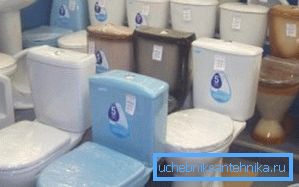
Toilet bowl classification
As you probably know, the appearance, shape, dimensions, material and other important characteristics of sanitary products are strictly regulated by GOST 30493-96. However, in order not to make it difficult for you to study all the subtleties and nuances of this document, let us dwell on the characteristics that most affect the use of the toilet bowl.
According to the design of the bowl
Any plumbing fixture consists of a storage tank, where the water used for draining is stored, and a bowl to which natural needs are sent. It is the main component of the toilet bowl and it depends on it how much the device will be used.
In addition, hygiene depends on it, that is, how effectively the surface of ceramics will be cleaned from biological residues after draining the water.

The main types of bowls and some of their features are presented in the table.
| View | Description |
| Funnel | The advantage of this design is an effective and fast discharge of water and good surface cleanability. At the expense of the funnel, located exactly in the center of the bowl, instantaneous removal of biological waste. However, in this case there is the possibility of a splash and splashing of dirty water droplets outside the toilet bowl. |
| Disc | In the bowl there is a special shelf for the accumulation of human waste products, which are then washed away by a powerful stream of water. Here, spraying is practically impossible, but the shelf is very poorly cleaned of residues of feces, therefore additional surface treatment is often required by a brush. Such designs were widely distributed in the middle and at the end of the last century, but now they are practically out of use. |
| Visor | Such toilets are used most often. The shape of the bowl is similar to a funnel-shaped, but is additionally equipped with a special projection that eliminates splashing. The optimal slope of the inner walls ensures high-quality cleaning of ceramics from contamination. |
The correct form contributes not only to high-quality cleaning of the surface from faeces.
A good toilet provides:
- fast and economical discharge of water;
- preventing the formation of mineral deposits on the surface of the device;
- minimal water spray.
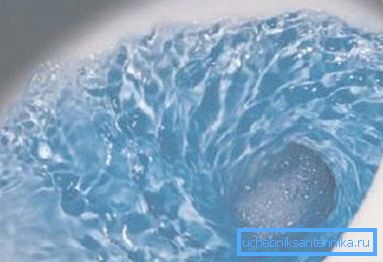
Note! Despite the fact that the bowl is the main element of the toilet bowl design, the drain tank also plays a significant role. A quality flush also depends on its shape, location and type of drain fittings.
By flush type
Modern toilets wash feces from the toilet bowl in three ways, each of which has its own advantages and disadvantages.
Consider in more detail:
- Direct (cascading). A stream of water coming from the storage tank flows down one side of the bowl. This method of flushing is very reliable, but does not ensure proper cleaning of the entire contaminated surface.
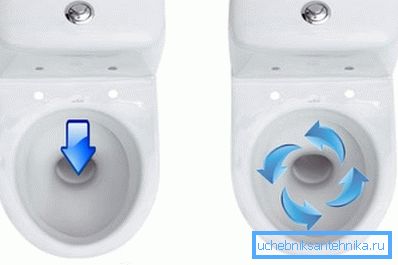
The advantages are the low price of such devices. Disadvantages - noise during operation, as well as the formation of a large number of splashes.
- Circular. In this case, the water jets are directed at different angles to the central hole, covering the entire inner space. Almost 100% of the surface is washed, when the water is drained, the flow of liquid makes almost no noise.
- Accumulative. It is a rather rare construction, which provides for filling the toilet bowl with a large amount of water, after which it is very quickly discharged (it reminds of the operation of the vacuum toilet in long-distance trains). The disadvantage is increased water consumption. One cycle consumes up to 8 liters of fluid.
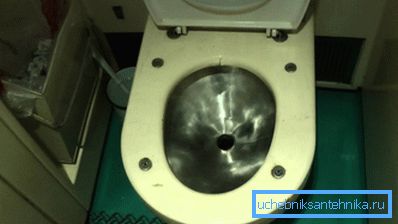
Tip! To save water used in the toilet, it is recommended to install a tank fitting with a separate drain. With its help, you will be able to regulate the volume of liquid with your own hands, which is spent on removing biological waste from the toilet bowl. By pressing one button, you will drain the entire tank, the second - only half of the water there.
The location of the exhaust pipe
All waste along with water from the bowl fall into the sewage system. To do this, the plumbing device must be connected to the drain neck of the corresponding pipe.

Consider the types of toilets with different systems of release of dirty water:
| View | Description |
| With oblique release | This type of sanitary devices was common in the 80s of the XX century. He allowed to connect the toilet to the cast-iron pipe sewer system without the use of adapters or cuffs. Now it is practically not applied, as the pipe laying scheme in residential buildings has changed. |
| Horizontal release | Most modern engineering networks are designed and constructed for the use of toilet bowls with horizontal (parallel to the floor) release. If the neck of the sewer pipe does not coincide in height with the toilet bowl nozzle, eccentric plastic cuffs or corrugated plastic pipes can be used for installation. |
| Vertical release | Designs of this kind came to us from the New World. There, sewage pipes are mounted completely differently. The advantages of such a scheme are simplicity of installation (cuffs are not needed) and the possibility to install a toilet without being tied to any of the walls of the room. |
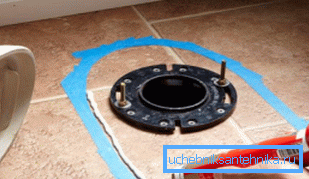
The choice of a specific type depends on how sewers are placed in your apartment or house:
- In the walls. Toilets with oblique and horizontal release are suitable.
- In interfloor overlappings. Uses a device with a vertical release.
By fastening method
Another important criterion is the method of fixing the sanitary device. From this depends on the design of the future premises, and the installation procedure, and features liner engineering networks.
There are two main types:
- Outdoor. Their cost is low, and you can install it yourself, without spending much effort. For fixing, you only need to drill a few holes, where to screw the studs in the dowels or anchor bolts.
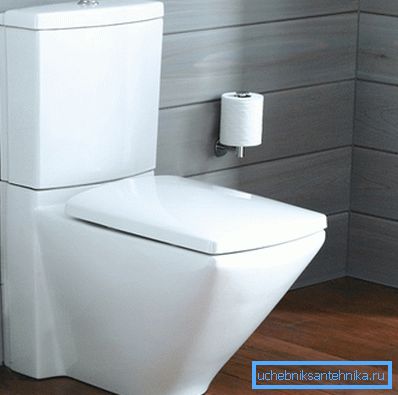
Can be placed both at the wall, and at some distance from it. When dismantling the decoration of the restroom is practically not damaged.
- Suspended. Costly designs that are recommended to be installed in small toilets. Suspended toilets are fixed on a special installation, which, in turn, is screwed to the wall.
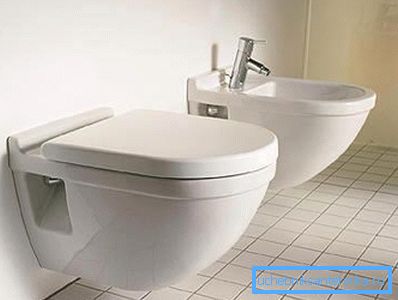
According to the material
For the manufacture of modern sanitary devices used:
- Faience. Differs in the low price and small durability. The material is characterized by high porosity, which complicates the care of the toilet. Modern technologies (glazing and so on), allow to get rid of some of the shortcomings, but, nevertheless, all the disadvantages can not be removed.
- Porcelain. More durable and ergonomic material. Due to its small pore size it absorbs less moisture. Toilet bowls from porcelain are widespread.
The only major drawback is the high cost.
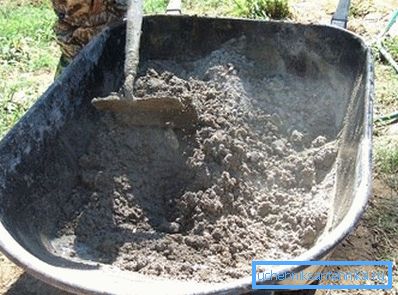
There are also toilets made of stainless steel, glass, stone, plastic, and so on. However, these are either designer models or devices that perform specific functions. In home construction are not common.
Classification of storage tanks
Having dealt with the bowls, consider the types of cisterns for the toilet:
- Separate container fixed on the wall. The design is hung over the toilet and is connected to the latter with a special drain pipe. The actuation of the drain fittings is carried out using a lever to which, for convenience of use, a chain or rope is attached. The advantages of this design - high-quality drain, but the water, escaping from the nozzle, makes a lot of noise.
Such designs were common about 50 years ago and are now rarely used.

- The capacity established on the shelf of a toilet bowl. Here the drain tank is attached to a special shelf, which is part of the bowl. Special bolts with rubber pads are used to firmly hold the structure in place.
The advantages of this solution are obvious:
- to install a sanitary device you need significantly less materials and accessories;
- simplified mounting device;
- there is no need to use a wall or other vertical surface as a supporting base.
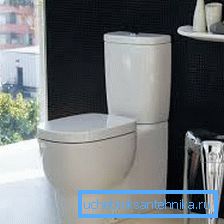
Note! A toilet with a cistern attached to the shelf can be installed not only against the wall, but also in any other part of the room. The main thing is to ensure the water supply and disposal of biological waste.
- Monoblock. This is a variation of the previous design. The shape resembles a toilet with an already installed capacity, but the latter is not placed separately, but is an integral part of the design. These are mainly designer models, the cost of which is quite high.
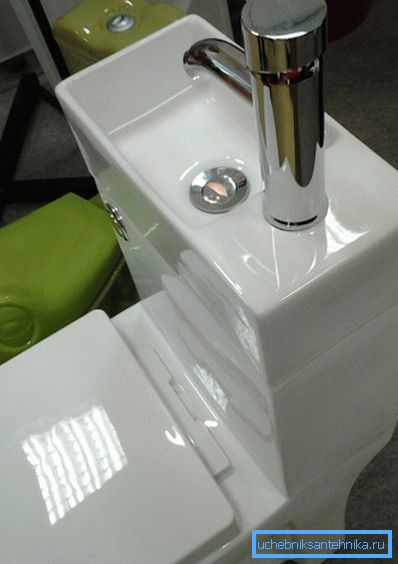
- Tank hidden accommodation. The cumulative water tank is masked into the wall so as not to introduce dissonance into the design of the room. Such a solution, among other things, helps to save space and provides an opportunity to disguise engineering communications.
Minus - the high cost and complexity of installation. To install the tank, use a special frame-installation, mounted on the wall, sheathed with plasterboard, which is then revetted with tiles.

- Toilets without cistern. Modern industry produces sanitary appliances, for the operation of which does not need a storage tank. In this case, the bowl is connected directly to the water supply. To drain, press and release the button that controls the flow of water.
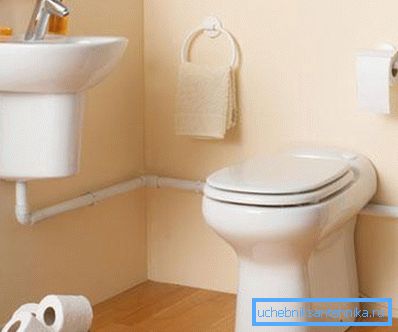
Conclusion
When choosing a plumbing device, pay special attention to how it will be used: for the equipment of your own home or commercial premises.
The fact is that some types of toilet bowls - inside of which there is a drainage channel of complex shape (for example, with a vertical pipe) - are more susceptible to the formation of blockages. In public places it is better to abandon their use. In more detail about arrangement of sanitary premises you can learn from the video in this article.